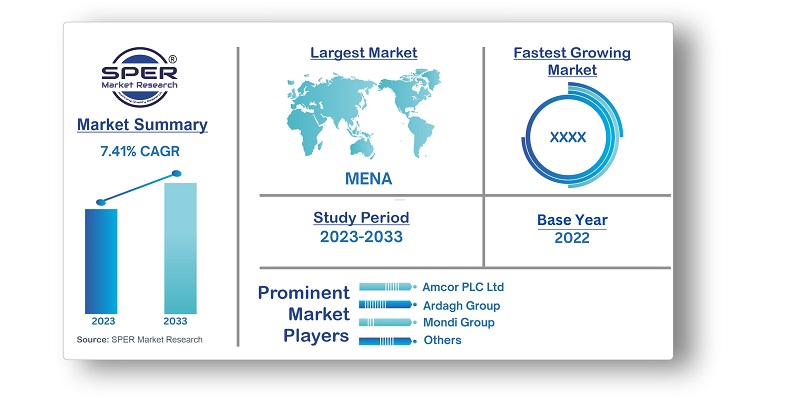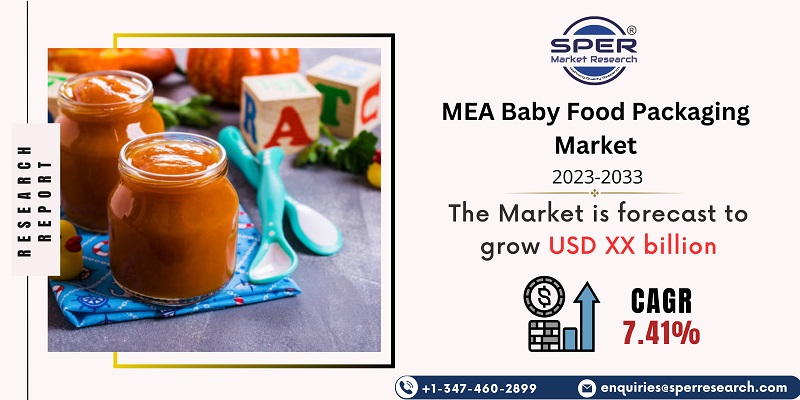
MEA Baby Food Packaging Market Growth, Size, Trends, Revenue, Challenges and Future Outlook
MEA Baby Food Packaging Market Size- By Material Type, By Product Type, By Package Type- Regional Outlook, Competitive Strategies and Segment Forecast to 2033
| Published: Aug-2023 | Report ID: PACK2324 | Pages: 1 - 154 | Formats*: |
| Category : Packaging | |||
- February 2021: Tetra Pak, a leading packaging company, aims to increase awareness about recycling's significance and facilitate Saudi Arabia's community in better utilizing recyclable materials.
- October 2021: Elopak is strengthening its position in emerging markets and committing to profitable expansion through the acquisition of Naturepak Beverage Packaging Co Ltd. Naturepak is a prominent provider of gable top fresh liquid cartons and packaging systems in the MENA region.

- Opportunities: Baby food packaging items are uniquely crafted for storing food intended for infants and young children. A diverse range of packaging materials, including glass jars, plastic containers, metal cans, folding cartons, and alternative solutions, are utilized for packaging various baby food products, encompassing dried foods, ready-made meals, and infant formula. Also, companies in the area are progressively adopting sustainable and recyclable packaging materials, actively seeking eco-friendly, inventive, and recyclable substitutes to conventional packaging methods.
- Challenges: The baby food industry faces significant hurdles due to the perishability of its products. To ensure extended shelf life, special packaging materials and preservatives are necessary, raising costs and affecting prices. Packaging flaws can compromise product quality and shelf life, leading to recalls and damage to manufacturers' reputations. These challenges pose risks to food manufacturers' relationships with packaging suppliers, potentially impeding the global baby food packaging market's growth, particularly due to perishability-related issues.

| Report Metric | Details |
| Market size available for years | 2019-2033 |
| Base year considered | 2022 |
| Forecast period | 2023-2033 |
| Segments covered | By Material Type, By Product Type, By Package Type |
| Regions covered | Kingdom of Saudi Arabia, United Arab Emirates and rest of Middle East & Africa |
| Companies Covered | Amcor PLC Ltd, Ardagh Group, Mondi Group, Sealed Air Corporation, Winpak Limited, Others |
- Babies and Toddlers
- Environmental Advocates
- Food Manufacturers and Distributors
- Gift Shoppers
- Nutritionists and Dietitians
- Parents and Caregivers
- Paediatricians and Healthcare Professionals
- Retailers
- Others
| By Material Type: |
|
| By Product Type: |
|
| By Package Type: |
|
- MEA Baby Food Packaging Market Size (FY’2023-FY’2033)
- Overview of MEA Baby Food Packaging Market
- Segmentation of MEA Baby Food Packaging Market By Material Type (Glass, Metal, Paperboard, Plastic)
- Segmentation of MEA Baby Food Packaging Market By Product Type (Dried Baby Food, Liquid Milk Formula, Powder Milk Formula, Prepared Baby Food)
- Segmentation of MEA Baby Food Packaging Market By Package Type (Bottle, Cartons, Jar, Metal Cans, Pouches, Other Package Type)
- Statistical Snap of MEA Baby Food Packaging Market
- Expansion Analysis of MEA Baby Food Packaging Market
- Problems and Obstacles in MEA Baby Food Packaging Market
- Competitive Landscape in the MEA Baby Food Packaging Market
- Impact of COVID-19 and Demonetization on MEA Baby Food Packaging Market
- Details on Current Investment in MEA Baby Food Packaging Market
- Competitive Analysis of MEA Baby Food Packaging Market
- Prominent Players in the MEA Baby Food Packaging Market
- SWOT Analysis of MEA Baby Food Packaging Market
- MEA Baby Food Packaging Market Future Outlook and Projections (FY’2023-FY’2033)
- Recommendations from Analyst
1.1. Scope of the report1.2. Market segment analysis
2.1. Research data source2.1.1. Secondary Data2.1.2. Primary Data2.1.3. SPER’s internal database2.1.4. Premium insight from KOL’s2.2. Market size estimation2.2.1. Top-down and Bottom-up approach2.3. Data triangulation
4.1. Driver, Restraint, Opportunity and Challenges analysis4.1.1. Drivers4.1.2. Restraints4.1.3. Opportunities4.1.4. Challenges4.2. COVID-19 Impacts of the MEA Baby Food Packaging Market
5.1. SWOT Analysis5.1.1. Strengths5.1.2. Weaknesses5.1.3. Opportunities5.1.4. Threats5.2. PESTEL Analysis5.2.1. Political Landscape5.2.2. Economic Landscape5.2.3. Social Landscape5.2.4. Technological Landscape5.2.5. Environmental Landscape5.2.6. Legal Landscape5.3. PORTER’s Five Forces5.3.1. Bargaining power of suppliers5.3.2. Bargaining power of buyers5.3.3. Threat of Substitute5.3.4. Threat of new entrant5.3.5. Competitive rivalry5.4. Heat Map Analysis
6.1. MEA Baby Food Packaging Market Manufacturing Base Distribution, Sales Area, Product Type6.2. Mergers & Acquisitions, Partnerships, Product Launch, and Collaboration in MEA Baby Food Packaging Market
7.1. MEA Baby Food Packaging Market Value Share and Forecast, By Material Type, 2023-20337.2. Glass7.3. Metal7.4. Paperboard7.5. Plastic
8.1. MEA Baby Food Packaging Market Value Share and Forecast, By Product Type, 2023-20338.2. Dried Baby Food8.3. Liquid Milk Formula8.4. Powder Milk Formula8.5. Prepared Baby Food
9.1. MEA Baby Food Packaging Market Value Share and Forecast, By Package Type, 2023-20339.2. Bottle9.3. Cartons9.4. Jar9.5. Metal Cans9.6. Pouches9.7. Other Package Type
10.1. MEA Baby Food Packaging Market Size and Market Share
11.1. MEA Baby Food Packaging Market Size and Market Share By Material Type (2019-2026)11.2. MEA Baby Food Packaging Market Size and Market Share By Material Type (2027-2033)
12.1. MEA Baby Food Packaging Market Size and Market Share By Product Type (2019-2026)12.2. MEA Baby Food Packaging Market Size and Market Share By Product Type (2027-2033)
13.1. MEA Baby Food Packaging Market Size and Market Share By Package Type (2019-2026)13.2. MEA Baby Food Packaging Market Size and Market Share By Package Type (2027-2033)
14.1. MEA Baby Food Packaging Market Size and Market Share By Region (2019-2026)14.2. MEA Baby Food Packaging Market Size and Market Share By Region (2027-2033)14.3. Kingdom of Saudi Arabia14.4. United Arab Emirates14.5. Rest of Middle East & Africa
15.1. Amcor PLC Ltd15.1.1. Company details15.1.2. Financial outlook15.1.3. Product summary15.1.4. Recent developments15.2. Ardagh Group15.2.1. Company details15.2.2. Financial outlook15.2.3. Product summary15.2.4. Recent developments15.3. Mondi Group15.3.1. Company details15.3.2. Financial outlook15.3.3. Product summary15.3.4. Recent developments15.4. Sealed Air Corporation15.4.1. Company details15.4.2. Financial outlook15.4.3. Product summary15.4.4. Recent developments15.5. Winpak Limited15.5.1. Company details15.5.2. Financial outlook15.5.3. Product summary15.5.4. Recent developments15.6. Others
SPER Market Research’s methodology uses great emphasis on primary research to ensure that the market intelligence insights are up to date, reliable and accurate. Primary interviews are done with players involved in each phase of a supply chain to analyze the market forecasting. The secondary research method is used to help you fully understand how the future markets and the spending patterns look likes.
The report is based on in-depth qualitative and quantitative analysis of the Product Market. The quantitative analysis involves the application of various projection and sampling techniques. The qualitative analysis involves primary interviews, surveys, and vendor briefings. The data gathered as a result of these processes are validated through experts opinion. Our research methodology entails an ideal mixture of primary and secondary initiatives.



Frequently Asked Questions About This Report
PLACE AN ORDER
Year End Discount
Sample Report
Pre-Purchase Inquiry
NEED CUSTOMIZATION?
Request CustomizationCALL OR EMAIL US
100% Secure Payment






Related Reports
Our Global Clients
Our data-driven insights have influenced the strategy of 200+ reputed companies across the globe.




















